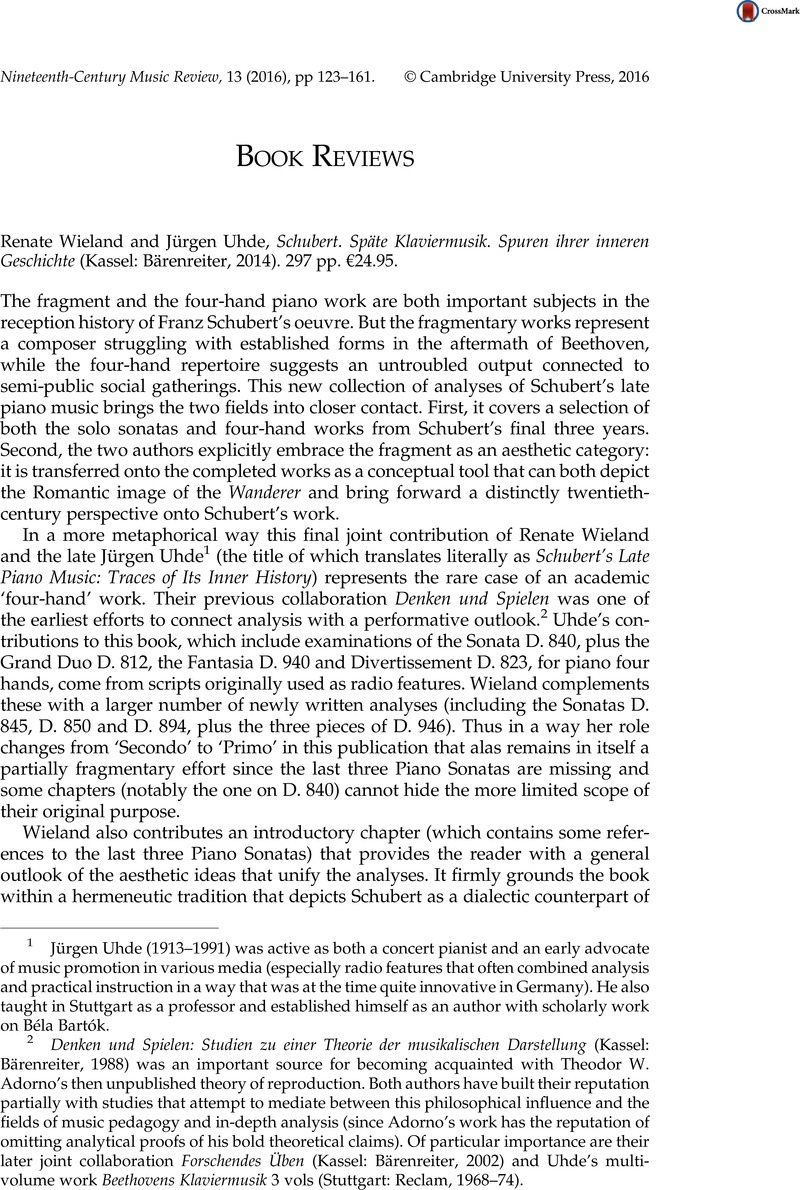No CrossRef data available.
Article contents
Renate Wieland and Jürgen Uhde, Schubert. Späte Klaviermusik. Spuren ihrer inneren Geschichte (Kassel: Bärenreiter, 2014). 297 pp. €24.95.
Published online by Cambridge University Press: 12 April 2016
Abstract

- Type
- Book Reviews
- Information
- Copyright
- © Cambridge University Press 2016
References
1 Jürgen Uhde (1913–1991) was active as both a concert pianist and an early advocate of music promotion in various media (especially radio features that often combined analysis and practical instruction in a way that was at the time quite innovative in Germany). He also taught in Stuttgart as a professor and established himself as an author with scholarly work on Béla Bartók.
2 Denken und Spielen: Studien zu einer Theorie der musikalischen Darstellung (Kassel: Bärenreiter, 1988) was an important source for becoming acquainted with Theodor W. Adorno’s then unpublished theory of reproduction. Both authors have built their reputation partially with studies that attempt to mediate between this philosophical influence and the fields of music pedagogy and in-depth analysis (since Adorno’s work has the reputation of omitting analytical proofs of his bold theoretical claims). Of particular importance are their later joint collaboration Forschendes Üben (Kassel: Bärenreiter, 2002) and Uhde’s multi-volume work Beethovens Klaviermusik 3 vols (Stuttgart: Reclam, 1968–74).
3 An important source within this tradition is the early essay of Adorno and its description of Schubert’s ‘crystalline’ formal thinking; it is reprinted for instance in Theodor W. Adorno, ‘Schubert’, Night Music: Essays on music 1928–1962, ed. Rolf Tiedemann, trans., Wieland Hoban (London: Seagull, 2009). Two more recent articles that focus on the most important aspect of this ‘extensive’ design – its amount of repetitiveness – are Billeter, Bernhard, ‘Wiederholungen bei Franz Schubert: Bemerkungen zur spezifischen Formproblematik’, Schweizer Jahrbuch für Musikwissenschaft 25 (2006): 217–248 Google Scholar and Burnham, Scott, ‘Landscape as Music, Landscape as Truth: Schubert and the Burden of Repetition’, 19 th Century Music 29/1 (2005): 31–41 CrossRefGoogle Scholar.
4 Particularly influential in German debates on these matters of musical time are the writings of the composer Dieter Schnebel. See for instance Schnebel, Dieter, ‘Auf der Suche nach der befreiten Zeit. Erster Versuch über Schubert’, in Musik-Konzepte: Sonderband Franz Schubert, ed. Heinz-Klaus Metzger and Rainer Riehn (Munich: Edition Text & Kritik, 1979): 69–88 Google Scholar.
5 An approximate translation is ‘Schubert’s music impels the desire for expansion to its extremes, and at the same time reflects the futility of all this striving’.
6 It should be mentioned that the terminology of gestures and topics in this volume is basically intuitive and not informed by the recent thorough investigations into these fields. However, the terminology still is designed to emphasize a perspective that can be shared between the analyst and the performer.





